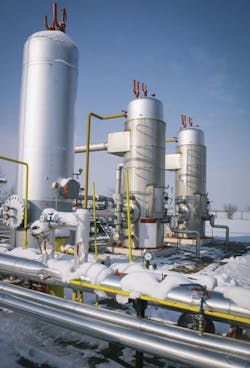Oil men have been sinking wells in the rolling plains of North Dakota for more than 50 years, and for most of that time they eked out a relatively modest living while their counterparts in Texas could drill at will and quite literally bathe themselves in the spoils of the endeavor. In the mid-1950s, less than 10 wells operated in the entire state of North Dakota and might produce a couple hundred barrels of crude on a good day — a fraction of a fraction of the nearly 6 million barrels sucked out of the ground nationwide every day at the time. Fast forward to September 2014 when, according to the state’s Department of Mineral Resources, 8,500 wells were in operation, extracting 1.1 million barrels every day from those very same fields.
Having become the second-largest producer of crude in the country, North Dakota is contributing to an oil and gas revolution in the United States. “This is unprecedented,” says Scott Duncan, a vice president of the construction industry analyst firm FMI. “We were just talking about peak oil a few years ago, but now we’re actually talking about the U.S. being one of the leading producers of oil in the world.”
With that reality setting in, the conversation has shifted to concerns over whether the construction industry can keep pace with the black gold rush, as it’s tasked with building out the facilities that will process and refine all of that oil. And it will be a steep hill to climb: In a recent report, FMI predicts that $330 billion will be spent on oil- and gas-related projects through 2017. For an industry that limped through the lean years of the recession, it’s a good problem to have, but with it comes a caveat: Labor demands, again according to FMI, will rise sharply, at a rate of 7% for the next three years. “If contractors aren’t reevaluating their recruiting practices now,” Duncan says, “they need to start.”
What the frack?
To understand the current oil and gas boom in the United States, you have to travel back to Texas in the early 1980s. There in the scrubland around Fort Worth, oil tycoon George Mitchell set about extracting natural gas that others said couldn’t be extracted. The gas was there — any geologist could have told you that — but it was trapped in thousands of square miles of highly porous shale, and traditional mining techniques were useless for accessing the diffuse deposits. While others considered the untapped gas a lost cause, Mitchell dug up an old technique first employed with little success in the 1940s — hydraulic fracturing, or fracking — and began experimenting with it. By injecting a mix of highly pressurized water, sand, and chemicals that his team perfected, he was able to break up the shale and pull out that previously unreachable gas. The experiment was something of a Hail Mary — Mitchell’s oil wells were on the verge of drying up at the time — but shortly after cracking the code (and the shale), he sold Mitchell Energy for $3.5 billion.
Fracking wasn’t just a boon for Mitchell. Fifteen years later it has also revolutionized the oil and natural gas industry, creating work where there had been little or none before. Lucrative drilling operations have cropped up in previously unreachable shale in eastern Colorado and west Texas. But neither can touch the frenzy surrounding the activity in North Dakota, particularly in the Bakken, a 200,000-square-mile deposit that lies under the western half of the state and extends well into Montana and Canada. That’s where most of the Interstates Companies’ oil- and gas-related wiring work has come from as of late. And the jobs have come so fast and in such great numbers that the Sioux Center, Iowa-based electrical contractor has had to work hard just to keep up. “They talk about a pending work shortage, and they talk about what’s going to happen in the next couple years,” says Interstates’ Benj Van Donge of FMI’s predictions. Van Donge recently took over as the contractor’s workforce development manager, a newly created position designed to address the increased labor demands. “I’m here to tell you that the shortage is here now, and it’s severe.”
Part of what makes electrical work in the oil and gas sector so plentiful is that it’s necessary at virtually every step in the process. The deposits in question are typically in rural areas where the grid isn’t built out, forcing many operations to rely on diesel generation for power. Then there’s the extraction equipment itself — including pumps and motors — which requires skilled electricians to get it wired and up and running. And the new factories and refineries under construction call for the same kind of control and instrumentation installation that any other industrial facility needs.
For Interstates, which, in recent months, has focused on work in the field at the drilling sites, the labor pains are twofold. While the increase in available jobs is undeniably a positive development, the available pool of workers has stagnated: Not only has the workforce dwindled — according to the U.S. Bureau of Labor Statistics, 20% of American workers will be over 65 by 2015 — but fewer young people are choosing to pursue a career in the trades. Add in skyrocketing wages (the going hourly rate for journeyman electricians in North Dakota is approaching $45, an almost $10 increase in less than a year), and the firm is faced with a virtually untenable situation. “Honestly,” says Van Donge, “it’s hard to find the words to describe a day in the life of an HR recruiter in this business right now.” After a pause, he continues. “We don’t have all of our eggs in one basket, for the sake of diversity. But the issue is, the oil and gas sector is getting a lot of the attention right now. And the wages are escalating, so you can’t blame an employee for going where the money is.”
On the other end of the spectrum is the Newtron Group and its subsidiary, Triad Electric and Controls. The firm has focused thus far on electrical and instrumentation work at gas terminals, oil refineries, and chemical plants. But it has yet to experience the pinch that Interstates has. That’s due at least in part to the companies’ conservative nature when it comes to pursuing projects. “We really know our comfort level,” says David Funes, a business development manager with the Baton Rouge, La.–based Newtron Group. “We’re passing on more work right now than we probably have in 10 years. And that has more to do with trying to manage things and not overcommitting ourselves than anything else.”
The other factor affecting the companies’ workload is a slower growth rate. Because Newtron and Triad work primarily on downstream projects, an increased demand for its services has yet to really kick in. “Most of what we’re looking at now is projects on the horizon,” Funes says. “We’re pretty busy, but the work that everyone is talking about — at least for us — will be in 2015 and beyond.” And as a result, labor has yet to become a topline concern.
At least there’s that
If there’s a bright spot in the current and impending labor shortage in the oil and gas sector — aside, of course, from the potential for all of that additional revenue that comes with a seemingly endless supply of projects — it’s that the workers themselves needn’t be uniquely qualified.
At Interstates, Van Donge says a robust training program, which has been in place almost as long as the firm has been in business, can prepare its electricians for whatever job comes up. “There are slight differences from one industrial job to another, but it’s not like we have to completely change our workforce,” he says. “We’re still training on the theory, the Code, and the practices of doing a quality installation — whether that be oil and gas or food and beverage or renewable fuels.”
In fact, beyond the skills that any electrician would need, he’s looking for workers who are willing to pack up and move at a moment’s notice. “We rely heavily on a labor market that is willing to travel to wherever these projects are at. Now we do recruit locally as well, but we still need what we call the traveling construction worker. If they’re on a project in North Dakota and the next one is in Colorado, they need to be willing to go there.”
Funes concurs, pointing out that the main line of demarcation runs between industrial and commercial work. “There’s really not a whole lot that separates somebody doing electrical work at, let’s say, a refinery versus at a paper mill.” And when making the leap from commercial to industrial, the biggest concern is — as would be expected — safety.
Drilling for new talent
So what are contractors doing to address increasing labor demands? The simple fact is that in the short term there’s not much they can do. With work far outpacing the rate at which young workers are entering apprenticeship programs, it could be years before the industry makes up any ground. There will be those firms like Newtron Group that proceed cautiously and take on only as many projects as they can handle without stretching themselves too thin. And in that case, a continued focus on recruitment at the technical college level and training will be key.
For Interstates, the approach will be significantly different. The firm’s executives hope to increase their workforce by 10% over the next four to five years. With a refusal to let potentially lucrative work slip away, Van Donge says he’s pushing himself to innovate in his approach to finding the next generation of electrical workers. “We can’t continue to recruit the way we have in the past, by just having some ads posted here or there and go to the technical colleges,” Van Donge says. Some of that starts with fighting back against the decades-old stigma that anything less than a degree from a four-year college is a sign of failure and reminding teenagers that there is no shame in the trades. “The skilled trades — an electrician, a welder, a pipe fitter — are very good jobs,” Van Donge says. “We need smart people to do those jobs.”
So with that in mind, Interstates has been making presentations at local high schools, bringing in newer employees who have graduated from a two-year technical college, gone through the company’s four-year apprenticeship program, and advanced within the organization. The hope is that those young role models — not to mention the lure of wages that can approach $40 an hour — will be enough to attract intelligent, tech-savvy students who otherwise would have gone to college because they didn’t know they had other options.
Van Donge knows that alone won’t be enough. In fact, it’s a long-term solution to an immediate problem. That’s why Interstates is beginning to look at a much more radical approach: poaching potential workers from other fields. The economy may be on the rebound, and unemployment levels may have dropped, but Van Donge is counting on the existence of frustrated cube dwellers who’ve grown weary of slaving for the Man. “We’re beginning to put plans in place, and they’re at the strategic level: What other segments of the population out there might be interested in a career change?” he says. “We’re looking at people who are mechanically minded, like to work with their hands, are critical thinkers, and are willing to learn a new trade.”
That doesn’t mean he’s only looking for young pups. “Let’s say a 30-year-old, 40-year-old, or 50-year-old walks in, and they have the ability and the desire,” he says. “You better believe we’re going to talk to them.”
Halverson is a contributing writer based in Seattle. He can be reached at [email protected].



